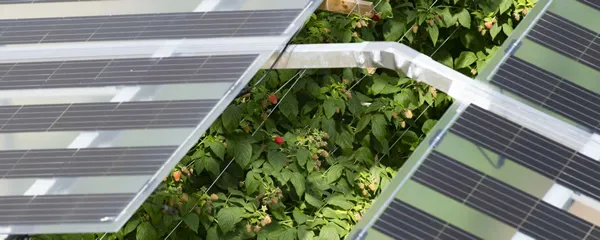Last year, the Dutch energy provider, GroenLeven, initiated a pilot project with five growers. They wanted to see how these farmers' fruit grew under solar panels. This is a world-first - considering solar panels' dual function in this way. Along with Wageningen University and Research (WUR), GroenLeven investigates the solar panels' effect on the crops. Although more research is needed this year, the initial results are very promising.
Maarten van Hoof farms in an area called Olland in the Dutch province of Brabant. He'd been thinking of putting up solar panels for two years already. He wanted to generate his own electricity and use it to cultivate blackberries, raspberries, and asparagus. He discussed the idea with fellow grower Piet Albers.
"Coincidentally, Piet had discussed the same idea with his brother. They wanted to see if they could grow raspberries and blackberries under these panels." The brothers were already in contact with solar energy specialist GroenLeven to discuss the possibilities. Van Hoof was keen to get involved too.
Research results
It turns out Van Hoof wasn't the only grower to think solar panels' dual function is a good idea. Last season GroenLeven placed test units at five farms. These were to measure how crops grew under solar panels. Piet Albers even already farms entirely under these panels. The panels are more transparent than standard solar panels. The plants need sunlight to grow, after all. GroenLeven commissioned Wageningen University and Research (WUR). They researched the panels' impact on the crops.
Initial research results show that the fruit's quality grown under the solar panels is the same as that cultivated conventionally - on racks covered in plastic. Diseases, too, plague these methods equally. Redcurrant bushes even produce more berries under the panels. That's because they're better protected against hail and rain. Raspberry bushes produce the same amount.
Strawberries and blackberries produce less fruit. But researchers say that's because the test started too late in the season. And the strawberries were under darker solar panels. The fruit under the more transparent panels grew better on average. Strawberries and blackberries are, therefore, being tested again this year. The blueberry season begins later. So there aren't any results for that crop yet.
180% land usage
Willem de Vries is a project leader at GroenLeven. He realizes smart dual-function energy solutions. "Here, the land is farmed and, and the same time, the solar panels generate sustainable energy. We call that Agri-PV, So, there's 180% land usage," says De Vries. That's in line with GroenLeven's vision. They want to make dual-function solar energy generation the norm. And thus substantially contribute to the energy transition. That's useful in the densely populated Netherlands.
De Vries praises these growers for their courage in taking part in this pilot project. "We're, of course, continually innovating this system. We want to get the best results. That's for both the crop and the electricity yield. Apart from that, nothing much changes for us."
"We still own the system and install the special panels. However, all sorts of things change on the farmer's side. For instance, they have to consider how and when they farm. That's why I respect them; we really need these kinds of growers during this energy transition."

Changes don't happen on their own
There's a lot involved in choosing these dual-purpose solar panels. That's because we're such pioneers, says Van Hoof. "My subsidy application was rejected several times because the permit wasn't adequate. I spoke to the municipality and made it clear that little would change structurally. I'd only be replacing the plastic-covered frames with solar panels. These frames protect the fruit. Fortunately, I was able to convince them."
So last year, Van Hoof replaced the first of his 1,100m2 of his plastic covering with solar panels. This is immediately more sustainable. There's less light so, so also a decreased risk of the fruit getting sun damage. That's why Maarten's taking his raspberries and blackberries out of cold storage later this year. "Less sunlight penetrates the panels, so harvesting starts two weeks later. Last year we started planting on 1 June. This year I want to begin as early as mid-April."
From five to two months of picking
If the yields under these pilot panels are good, Maarten wants to cultivate his entire 10ha of soft fruit under solar panels. "Then I can use the green power I generate. I can use it for my cold stores and the migrant pickers' housing." To do so, Van Hoof has to expand his cooling capacity. That's because the fruit under the panels ripens at the same time.
"That's the challenge. We now pick in five months; that will be reduced to two. That's why I need more space to accommodate more migrant workers during the picking season. But there's also a big advantage. I don't have to buy plastic foil anymore. And, of course, I'll be generating sustainable energy."
Van Hoof is putting off investing until he sees how his blackberries and raspberries fare this year. He is, however, very optimistic. He'd also like to double his asparagus soil usage. But the solar panels' run across the ground. And asparagus are grown in the full soil, while soft fruits are grown in pots. That makes things difficult.
GroenLeven is always open to innovative ideas, says De Vries. "We're going to do a pilot with cherries, apples, and pears. That's in the next two years. We think it's vital to know how the panels affect crops before we start installing them." If this proves to also be successful, more and more growers will opt to use such dual-purpose systems to make their farms more sustainable.
For more information:
GroenLeven
Tel: +31 (0) 587 990 000
Website: www.groenleven.nl
